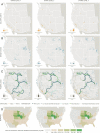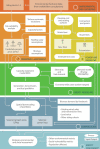Minimizing habitat conflicts in meeting net-zero energy targets in the western United States
- PMID: 36656853
- PMCID: PMC9942791
- DOI: 10.1073/pnas.2204098120
Minimizing habitat conflicts in meeting net-zero energy targets in the western United States
Abstract
The scale and pace of energy infrastructure development required to achieve net-zero greenhouse gas (GHG) emissions are unprecedented, yet our understanding of how to minimize its potential impacts on land and ocean use and natural resources is inadequate. Using high-resolution energy and land-use modeling, we developed spatially explicit scenarios for reaching an economy-wide net-zero GHG target in the western United States by 2050. We found that among net-zero policy cases that vary the rate of transportation and building electrification and use of fossil fuels, nuclear generation, and biomass, the "High Electrification" case, which utilizes electricity generation the most efficiently, had the lowest total land and ocean area requirements (84,000 to 105,000 km2 vs. 88,100 to 158,000 km2 across all other cases). Different levels of land and ocean use protections were applied to determine their effect on siting, environmental and social impacts, and energy costs. Meeting the net-zero target with stronger land and ocean use protections did not significantly alter the share of different energy generation technologies and only increased system costs by 3%, but decreased additional interstate transmission capacity by 20%. Yet, failure to avoid development in areas with high conservation value is likely to result in substantial habitat loss.
Keywords: biodiversity; carbon neutrality; land use; renewables; siting.
Conflict of interest statement
The authors declare no competing interest.
Figures







References
-
- Rogelj J., et al. , Mitigation Pathways Compatible with 1.5∘C in the Context of Sustainable Development (chapter 2). Global Warming of 1.5∘C. An IPCC Special Report on the impacts of global warming of 1.5∘C above pre-industrial levels and related global greenhouse gas emission pathways, in the context of strengthening the global response to the threat of climate change, sustainable development, and efforts to eradicate poverty p. 82 (2018). 00011.
-
- Clean Energy States Alliance, Table of 100% Clean Energy States (2022).
-
- Williams J. H., et al. , The technology path to deep greenhouse gas emissions cuts by 2050: The pivotal role of electricity. Science 335, 53–59 (2012). - PubMed
-
- Intergovernmental Panel on Climate Change , Chapter 6: Assessing Transformation Pathways: Climate Change 2014 Mitigation of Climate Change: Working Group III Contribution to the Fifth Assessment Report of the Intergovernmental Panel on Climate Change (Cambridge University Press, Cambridge, 2014), p. 00150.
-
- Williams J. H., et al. , Carbon-neutral pathways for the United States. AGU Adv. 2, e2020AV000284 (2021).
Grants and funding
LinkOut - more resources
Full Text Sources

